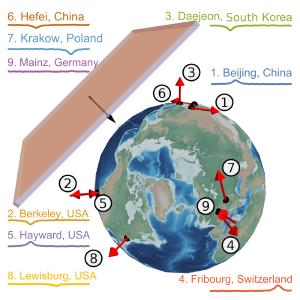Blog
Dark World
22 January 2022
Axions are a popular candidate in the search for dark matter. There have been previous searches for these hypothetical particles, all of which have come up with nothing. But recently the results of a new search for dark matter axions have been published…and has also found nothing.1 Still, the study is interesting because of the nature and scale of the search.
Axions are a type of hypothetical particle first proposed in the 1970s. They weren’t proposed to solve dark matter, but rather to address certain aspects of the theory of quantum chromodynamics, which describes the strong nuclear force. According to the theories, would be low mass, chargeless particles that don’t interact strongly with light. Sounds a bit like dark matter, doesn’t it?
 Wikipedia user Gorchy
Wikipedia user GorchyIf axions do comprise dark matter, then one of the more subtle effects is that their quantum field would have topological defects. Basically, the axions would tend to cluster into oriented regions on scales smaller than a galaxy, but larger than Earth. It’s similar to the way unmagnetized iron contains crystals, where each crystal has its own magnetic orientation. Since the crystals are randomly oriented, on a large scale the overall magnetic field of the iron averages to zero. But on a small scale, there are domains with a uniform magnetic field, with domain walls between each region.
 Hector Masia Roig
Hector Masia RoigThis new study attempts to measure an axion domain using the Global Network of Optical Magnetometers for Exotic Physics Searches (GNOME). It’s a network of 14 sensitive magnetometers in labs all over the world. Nine of them were used in this particular study. The experiment involved using laser light to magnetically align a collection of atoms. If a dark matter axion were to interact with the atoms, it would cause the magnetic field of the atoms to shift slightly, which the magnetometer could detect. This kind of small perturbation happens randomly all the time with atoms, but since an axion field domain is larger than Earth, axions at every lab should tweak atoms in the same way. What’s more, if Earth happened to pass from one axion domain to another, the axion perturbation should shift in the same way all across the globe.
The team gathered a month of continuous data and ran statistical correlations between labs. What they found was a wash. The atomic perturbations were indistinguishable from random noise. That doesn’t mean the experiment was a failure. The experiment places certain constraints on the possible mass of axions. Any theory proposing axion dark matter can’t have axion particles in this range. The team is moving forward with more sensitive studies that will either discover axions or further constrain them.
At this point, the search for dark matter seems to repeat the same tale. Look for a particular type of dark matter particle and fail to find them. But often that’s the way science works. We love stories of the eureka moment, where a brilliant discovery changes the world. But often science is more of an excavation, where failed hypotheses are scraped carefully away until what remains is the truth.
S. Afach et al. “Search for topological defect dark matter with a global network of optical magnetometers.” Nature Physics 17.7 (2021): 1396-1401. ↩︎